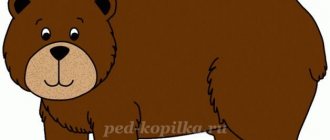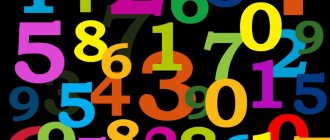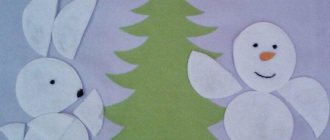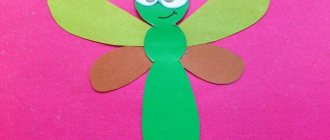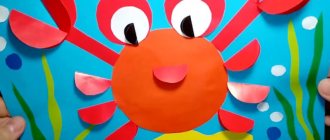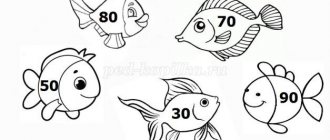Children become familiar with greater and less than signs in mathematics even before entering first grade. Children often get confused about what a specific symbol means. Parents can help their children in this matter, which will have a positive impact on their children’s academic performance. This knowledge will be useful to kids in the future - when studying geometry, in algebra lessons, in examples where square and other powers of numbers are used. The tips in this article will help parents teach their kids important mathematical wisdom.
Greater than or equal to / less than or equal to signs
The signs “greater than or equal to” and “less than or equal to” look like “≥”, “≤” respectively. They are the result of combining two characters - ">" or "<" and one line.
This line is below the arrow. In this case, the arrow does not intersect with the line below it. Typically the bottom line follows the principle of being parallel to the bottom of the symbol.
These signs are used in non-strict inequalities. In first grade, such inequalities are usually not studied.
"Arrows"
Primary school children need to explain signs based on the principle of comparing them to arrows that are directed in opposite directions. In this case, it is important to clarify that the arrow always points to the number that is smaller. If the child learns this, then he will not have any difficulties with making signs. He can easily determine how to place the arrow correctly.
Children have difficulties when reading expressions. But they are also easy to eliminate: if the sign is placed correctly, then they will read the expression without problems. After completing a small number of tasks, it will become clear to the child that an arrow pointing to the left means a “less” sign, while an arrow pointing to the right means “more.”
Games for quickly memorizing the signs “greater than” and “less than”
There are various logic games using mathematical symbols. There are many such games. Below are three games where children can play with the ">" and "<" arrows.
Game "Big Hungry Crocodile"
This is the easiest and most visual way to remember once and for all which way the “greater than” and “less than” signs are written. On a sheet of paper you need to draw two round plates. The diameter of each plate must be at least 10 centimeters.
On each of the “plates” you can put something roughly resembling food. For example, you can make balls from plasticine or salt dough and agree with your child that the peas mean crocodile cutlets. For this game it is enough to make one symbol. It can be done on a small card. The notations “>” and “<” roughly resemble the open mouth of a crocodile.
An important condition is that the crocodile always chooses only the plate that has the most food on it!
You need to tell your child about this.
It is necessary to place a certain number of “cutlets” on both “plates”. Then have the child place the card so that the “crocodile’s mouth” faces toward the “plate” that has more “cutlets” on it.
Game "What is more?"
In this game, the combination of the thumb and index finger of the left hand represents the symbol "<", and the combination of the thumb and index finger of the right hand represents the symbol ">". To indicate what is greater, it is enough to extend your right hand, and the left hand is needed to indicate what is less.
In this comparison game you can use not only numbers, but also images of various objects, as well as geometric shapes of different sizes. This activity game can be performed during meals by placing cookies, candies, apples and other foods on the table. This is how you can remember the correct spelling of signs long before school.
Game "Cubes and boards"
This game belongs to the category of active games, since children need to perform actions not only of a mental nature, but also to be active builders. For this game you will need the following supplies: large cubes and two straight boards. One board must be placed on a horizontal surface. Place the cubes in columns on both edges of the lying board.
It is important that the columns be even, like an exclamation point. For example, the first (left) column consists of 4 cubes, and the second of 2. Then you need to put the second board on both posts. Eventually, the combination of the bottom and top boards will reveal the correct symbol. In this example, the notation “>” will be obtained.
With each subsequent time, you can change the number of cubes in the columns. When the columns contain the same number of cubes, the boards will show “equal”.
"Hungry Bird"
You will need a sign - an open beak of a bird (the “more” sign). You can make it from cardboard or take a disposable plate. To arouse the child's interest, you can add beak, eyes and other parts of the body.
Start explaining like this: “This bird loves a hearty lunch. And she will choose the heap that is larger.” Then clearly demonstrate how she opens her beak in the direction where there are more grains.”
To consolidate the information received, place 2 piles of grain on the table and ask the child to determine where the bird will turn its beak. If he doesn’t succeed the first time, repeat to him that the beak needs to be opened to the side where there is more food. Next, offer him several similar tasks, for example, writing numbers on paper.
For variety, the bird can be replaced with another predatory animal (crocodile), which will open its mouth to the side with more. If a situation arises where both piles contain the same amount of food, and the child notices this, this indicates his attentiveness. For this you will need to praise the baby and show him two equal stripes. It should be made clear that they are equal to the number of items in each pile. Therefore, such a sign is called “equal”.
Equality and inequality
What is equality in mathematics is when one thing is similar in quantity to another and you can put an = sign between them.
For example, let's look at a picture depicting geometric shapes. The quantity on the right and left is the same, which means you can put the “equals” symbol.
An inequality is an algebraic expression that uses the signs ≠, <, >, ≤, ≥.
A clear example of inequality is shown in the picture below. We see three figures on the left, and four on the right. At the same time, we know that three is not equal to four, or else: three is less than four.
A lesson at school often takes place in front of a textbook, notebook and blackboard. At home, you can use a computer and complete some tasks online. How to find characters on the keyboard? The answer is in the picture:
How and in which direction the sign for more is written
The greater-than sign is written as “>”. The symbol is indicated by an arrow, the direction of the acute angle of which is directed to the right. A little theory: the determining factor is the left side of the symbol. If the arrow starts with two lines that converge at one point on the right side, then this is a “>” sign.
In general, the logic of understanding is very simple - whichever side (larger or smaller) the sign in the direction of writing faces to the left is the sign. Accordingly, the sign looks more to the left with its wide side - the larger one.
An example of using the greater than sign:
- 50>10 – the number 50 is greater than the number 10;
- Student attendance this semester was >90% of classes.
How and in which direction the less sign is written
How to write the less sign is probably not worth explaining again. Exactly the same as the greater sign. If the sign faces to the left with its narrow side—the smaller side—then the sign in front of you is smaller.
An example of using the less than sign:
100 =”, which, in principle, is often quite acceptable, but can be made more beautiful and correct.
In fact, in order to type these characters, there are special characters that can be entered on any keyboard. Agree, the signs “≤” and “≥” look much better.
The less-than sign looks like “<”. To put it simply, the arrow should point to the left. Again, the left side of the arrow is important for identification. If the point from which two lines emerge is located on the left, then this is the symbol “<”.
- 100<500 – the number 100 is less than the number five hundred;
- <50% of deputies attended the meeting.
As you can see, everything is quite logical and simple, so now you should not have questions about which direction to write the greater sign and the less sign in the future.
Types of inequalities
- Strict inequalities - use only the greater than (>) or less than (<) sign.
- a < b - this means that a is less than b.
- a > b - this means that a is greater than b.
- the inequalities a > b and b < a mean the same thing, that is, they are equivalent.
- Loose inequalities - use comparison signs ≥ (greater than or equal) or ≤ (less than or equal).
- a ≤ b - this means that a is less than or equal to b.
- a ≥ b - this means that a is greater than or equal to b.
- the signs ⩽ and ⩾ are opposite.
- Other types of inequalities.
- a ≠ b - means that a is not equal to b.
- a ≫ b - means that a is much larger than b.
- a ≪ b - means that a is much smaller than b.
- the signs >> and << are opposite.
Sources
- https://skysmart.ru/articles/mathematic/znaki-bolshe-menshe-ili-ravno
- https://kakpravilno05.ru/kak-pishetsja-znaki-bolshe-i-menshe-v-matematike/
- https://linchakin.com/%D1%81%D0%BB%D0%BE%D0%B2%D0%B0%D1%80%D1%8C/%D0%B7/%D0%B7%D0%BD %D0%B0%D0%BA%D0%B8_%D0%B1%D0%BE%D0%BB%D1%8C%D1%88%D0%B5_%D0%B8_%D0%BC%D0%B5%D0 %BD%D1%8C%D1%88%D0%B5/
- https://nauka.club/matematika/znak-bolshe-i-menshe.html
- https://Sprint-Olympic.ru/uroki/matematika-uroki/92800-znaki-bolshe-i-menshe-v-matematike-sravnenie-chisel-s-primerami.html
[collapse]
Consolidation exercises
After explaining the rules for placing a sign, you need to practice performing similar tasks.
For this purpose, tasks of this type are suitable:
- “Place a sign” (4 and 5 – you need a “less than” sign).
- “More or less” - the child shows signs with the thumb and forefinger of both hands, comparing the sizes of various objects or their quantity (an airplane is larger than a dragonfly, a strawberry is smaller than a watermelon).
- “What number” - there are signs, the number is written on one side, you need to guess what number will be on the other side (in the expression “_<5” the numbers 0 – 4 can appear in the blank space).
- “Add the numbers” - you need to correctly place the numbers to the left and to the right of the indicated sign (the number 8 will be to the left of the “greater than” sign, and the number 2 will be to the right).
To develop logic and thinking, you can supplement the exercises with the following tasks:
- “Which direction did the object run away from?” — 3 triangles are drawn on the left, 2 squares on the right, and between them there is a “=” sign. The child must guess that there is not enough square on the right for the equality to be true. If you can’t do this right away, you can solve the problem practically by first adding a triangle to the left, and then a square to the right.
- “What needs to be done to make inequality right?” — taking into account the situation, the child determines on which side objects need to be removed or added so that the sign stands correctly.
Video info lesson will tell you about the signs: greater than, less than and equal to
